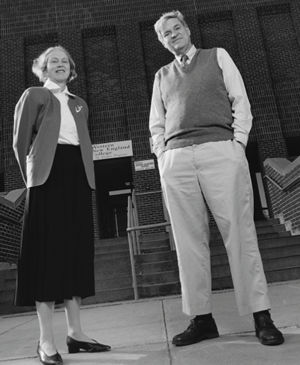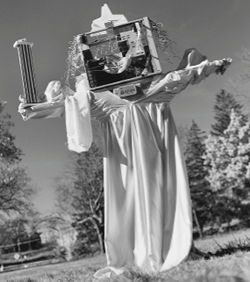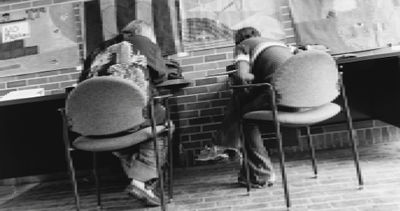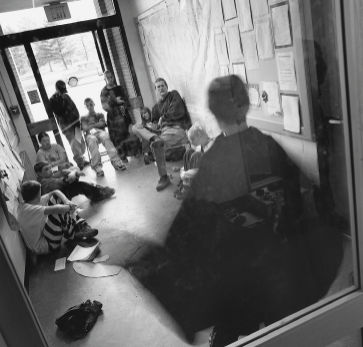The Francis W. Parker Charter Essential School opened in the fall of 1995, housed in an almost windowless building where the U.S. Army intelligence experts and cryptographers based at Fort Devens, Massachusetts, once were trained. The closing of the base provided the school with much of its furniture and equipment and one telling artifact: a massive map of East Germany that covered the wall of a basement classroom.
Parker’s motivating idea is its common, carefully focused and interconnected academic curriculum, which is shaped by “essential” questions in two major areas: Mathematics/Science/Technology, including Health, and Arts and Humanities, including Spanish. Each of our 340 students, ages 12 to whatever it takes to meet the graduation standard, has a Personal Learning Plan, effectively a contract among student, school, and family. Students are promoted through three Divisions, irrespective of their ages, by public presentation of portfolios and, for older students, Exhibitions. Our limited budget (per-pupil expenditure is up to 15 percent less than nearby district high schools) allows for a spare but spirited jazz band and interscholastic athletic, debate, chess, and mock trial teams. The best measure of Parker’s success? A long waiting list for the 2000–01 academic year.
 |
| Veteran educators Nancy and Ted Sizer and several colleagues accepted the challenge of Massachusetts’ charter school law—to build a new school upon a visionary foundation.
|
The school was born of three parents’ desire to have an alternative to their town’s school. They, in turn, were inspired by the ideas put forth in a book, Horace’s Compromise, written by one of their neighbors, Ted Sizer. “Horace” is Horace Smith, a fictional representation of a typical high school teacher who is caught in a job he cannot do at the standard he knows his students deserve. He serves too many of them to know each one well, to analyze their strengths and weaknesses, to meet with them in conferences, to be trusted enough to offer the constructive criticism that is necessary for their growth. Horace’s school, its routines mechanical, its purpose undefined, is an unconnected smorgasbord of programs, courses, activities, and more. In the end, it is the students who are expected to make sense of it all. And so Horace compromises to get along. Without substantial changes in the way his school is organized—indeed, in the way its best values are expressed—he will be stuck doing second-class work in a genial, well-intentioned, but basically directionless place.
Horace’s Compromise also inspired the creation of the Coalition of Essential Schools in 1984, first based at Brown University and now an independent non-profit organization situated in Oakland, California. The Coalition’s mission is to help create and support the growth of schools that salve Horace’s frustrations, by providing an education that is more integrated and focused than the usual. The experience of Essential schools in New York City, especially the celebrated Central Park East Secondary School, created by Deborah Meier and her colleagues, persuaded us that it was possible to create a high school that dared to develop the most essential intellectual habits in young people—in a way that was demonstrably practical and public (meaning open to all students) and had long-term positive effects on students.
 |
| Students celebrate Halloween at the Parker School.
|
The charter school provision of the Massachusetts Education Reform Act of 1993 gave these parents, the two of us, and several other colleagues our opportunity. With the Coalition’s principles of school practice in mind, we hastily began developing our school plan. Some decisions were easy: to provide a program from 7th grade through graduation; to move students through the program on an individual basis; to ask our teachers to be well educated, but to act more as generalists than specialists; to keep teachers’ student loads down, and to offer advisories instead of more formal and distant “guidance counseling”; to offer only one foreign language, but to expect all to learn it; to put our money into more adults, some of them young adults, rather than into high rents or new furniture.
Other decisions were harder. How theoretical did we want our curriculum to be? How practical? In a promotion system based on demonstrated competence, what would be our benchmarks? How would they be made clear to teachers and to students and their parents without becoming rigid and meaningless? How would we help our teachers to adapt to classrooms in which projects would often replace the usual chalk-and-talk? How could we be good neighbors to the schools in our area from which we might enroll students? How could we fashion a diverse student body, yet still draw students from towns that provide a higher per-pupil allocation?
What follows is the story of the ups and downs of going from the germ of an idea to a secondary school that serves students ages 12 and up—in short, the ways in which we avoided Horace’s compromises or coped with those compromises we couldn’t avoid.
Sweat Equity
The ideas behind our school and the motives for starting it were the relatively easy part.The start-up of any organization plunges its leaders into a welter of unanticipated or underestimated problems. From its very beginning, Parker confronted a number of challenges—everything from financial difficulties to engaging our teachers in a unique and demanding curriculum.
Like almost every charter school, the Parker School has had its share of financial concerns, especially during the start-up phase. For the most part, charter schools, once open, receive funds for ongoing operations, but the months before opening day are funded largely by the founders’ sweat. The development of an institution’s ideas takes time; not just anyone’s time, but the time of experienced and busy people. And so it was that parents and students were repairing, carrying, and washing furniture late at night, while teachers were doing every kind of job, from planning classes to washing windows to driving to the store to buy erasers. In each of our first meetings, whether we were hashing out our guiding principles or writing the charter application or recruiting our first potential students or deciding when—and how—to hire our first employees, we must have worked for love because we certainly were not working for money. When we trustees stopped by, we were likely to be put to work. Save for some federal money (which came late), the detailed planning of the Parker School and the training of its staff had to be done pro bono.
 |
| The course of study at the Parker School, where the focus is on developing students’ intellectual habits, runs narrower and deeper than the typical high school’s.
|
Massachusetts’ charter schools—places that were to break the mold and chart new directions, no less—apparently were to be designed in persuasive detail by spontaneous combustion, with hardly any support from the state. That some of us designing Parker had substantial experience made our task easier—though never easy—but we were the exception. Only the big for-profit companies have the financial horsepower to create fresh material. Schools that have sprung from the grassroots public interest of a community have had to make do with very little to nothing. It is, therefore, no surprise that too many charter schools are either weak or, in their unthinking copying of existing practice, still hampered by the compromises that bedeviled Horace. Powerful new, complex institutions require up-front research and development. That means money. Charters are getting little of it, and rarely at a scale that could make a substantial difference. Serious start-up schools need ready physical facilities, adequate R&D funds for the initial planning, and at least half of the faculty hired and involved in planning and training for at least nine months before the school opens.
Left Hand, Right Hand
Like most applicants for a charter, we were attracted by the idea that we could shape our own mission, present it to the state’s chartering authorities, and then be held to our own, but externally validated, standards. Thus Parker wrote an application for a charter that detailed our educational goals, our strategy for meeting those goals, and a means of carefully assessing, internally and externally, whether we had reached those goals. Parker chose to keep doggedly to the “essentials”—designing a curriculum that covered a small number of topics in extreme depth, rather than lightly touching on a broad range of material.
Parker’s planners worked “backwards.” We visualized the kinds of graduates we would be proud to send into the world.We started with the habits, skills, and content we wanted our students to learn, and then we planned the curriculum and teaching styles to reach those aims. We found that being reasonably clear about what a student should know and be able to do as a matter of habit led to an ever narrower and deeper program.
For example, if the school expected every graduate to display clear and even marginally graceful expository prose, then there had to a great deal of writing, not just in Humanities but in the other domains as well. That writing had to be assessed—which meant teacher time, often preceded by teacher training. We had to ask ourselves, What will be our standard for Division III expository writing? How will we determine whether students have met it, and what will it take to get most, if not every last one, of our kids to that level? And what standard should apply to children who are identified as having “special needs”?
Such “backwards planning”is commonsensical yet rare in public education. Instead there are lists of topics to cover and skills to achieve, and these are rolled out in central headquarters with little regard to pedagogical and scholarly realities. The giant textbooks so familiar in American high schools are testament enough to that; in most, there is something included for every political pressure group. The result is “scholarship” by hop, skip, and jump, one of Horace’s most painful compromises.
At times, these conflicting approaches made life at Parker rather difficult. For instance, the state Board of Education approved all the aspects of our charter proposal. But in a different policy context it asserted that the state’s charter schools had to follow the unusually comprehensive state curriculum frameworks (thus, in our view at least, guaranteeing a curriculum that will be geared toward superficial mastery by most students). Our students also had to pass standardized tests derived from those frameworks. In many ways, these conflicting signals reflected little more than the left policy hand not knowing what the right policy hand was doing, but it placed and still places Parker in a compromised position. Nevertheless, and counterintuitively, our students score competitively on state tests.
The strains of the state’s dual agenda are especially evident during testing season. Since we group our students (on the basis of their exhibited performance) into three Divisions, each with an approximately two-year curriculum designed by our teachers, the state’s pattern of testing 8th and 10th graders (a designation we don’t make, on philosophical grounds) is especially hard on our students. Our emphasis in Arts and Humanities shifts from world topics one year to American topics the next, which means that those who take the tests may well have studied the material only in the previous year. Furthermore, when “10th graders” are pulled out of class to take extensive tests, new curricula must be devised for the “9th graders” who are left behind. Too much energy must go toward mitigating the disruption, even more than in other schools. Everyone is stretched, with little actual learning to show for it.
 |
| Teachers at Parker benefit from low student loads that allow them to engage students on an individual level.
|
In the spring of 2000, we had yet another dilemma. For several weeks, the entire curriculum in Division II Arts and Humanities was devoted to preparing for a trip to Washington, D.C., during which every student participated in a visit to the office of a member of Congress to advocate for a bill that was before Congress. The students learned about the substantive reasons for and the politics behind the legislation they were researching, the ways in which bills become laws, the opportunities citizens have to take part in the process, and the most persuasive ways of presenting their cases. It was a superb civics lesson, and the vast majority of the students showed, in a variety of observable ways, that they had learned powerfully from it. However, while their enthusiasm about their experiences augurs well for the fate of the republic, what they learned is not likely to be an item on this year’s test. Effective charter school policy requires consistency from the state, both in protecting what the approved charter asserted and in assessing a charter school’s success in ways that are consistent with its charter.
Building a Staff
The challenge of any “new” school, charter or otherwise, and especially a school that wishes to adopt new ways of teaching, is to build a competent, experienced staff with the expertise and energy to work in a start-up. Teacher education has largely been a matter of the “great old dogs” teaching eager new dogs the best of their tricks. The problem is that some of the old tricks are not very effective in schools that rest their programs, as does Parker, on one or another branch of serious contemporary research. Teaching toward intellectual academic habits such as, in Howard Gardner’s phrase, “thinking like a scientist” is more than mere “coverage” of “material” to be displayed only at the immediate completion of a “course.” Truly demanding intellectual training is not cookbook, easily routinized stuff. It is challenging work, particularly if high school students are used to getting by within the old, familiar system. The clash of minds, the give-and-take that leads a young person to a responsible and usable grasp of a consequential idea is sophisticated business.
In such a school, teachers must have time away from children each day to focus on their teaching, on their students’ work, and on learning from their colleagues. Every teacher at Parker has one to two hours daily away from class. Within a tight budget, this is accomplished by offering only a narrow core program. Parker’s designers regarded this as a worthy trade-off.
Another personnel trade-off we tried to make didn’t work as well. In order to achieve low teaching loads, we tried to conserve money by keeping overhead low. Parker started with a “leadership team” consisting of only two “lead” teachers, a business manager, and a part-time “coordinator.” This helped to achieve low student loads—65 or fewer per teacher, including advisories of 12 students per teacher—but, by January of our first year, the trustees and the faculty knew this leadership arrangement would not work. The workload was more than an overworked quartet could handle.
And so, still believing that less is more when it comes to “administration” (which we too easily confused with “leadership”), we hired a proven teacher/principal. He carried both tasks for 18 months and then everyone, including him, cried Uncle. The work was too demanding. So much of the school was new, and creating (and then recreating) fresh practices took time, intense concentration, coordination, and a level of imagination that rarely emerges for overworked people at 2 A.M. Young teachers needed support. Parents and prospective parents needed endless explanations of our school’s design. The state expected the principal to serve not only as a typical Massachusetts school leader, but also as superintendent. Money, being in short supply from state sources, had to be raised. The list was endless.
 |
| Truly demanding intellectual training is not easily routinized stuff. It is challenging work, particularly if students are used to getting by in the old system.
|
At this point Parker’s trustees turned to two retired school veterans on the board (the authors of this essay) to act together, pro bono, as the principal. This bought Parker a year to think through its leadership requirements, to restructure the budget to allow for the appointment of experienced administrators, and to complete a search for a senior leader. But the general problem remains: There is a severe shortage of adequately prepared people rising to leadership, especially educational leadership of new ventures.
Culture Matters
We tried to create a distinct culture in our school, one that taught lessons in its own right. From the beginning, we were determined to include our students as full-fledged fellow pioneers. We valued them and admired their bravery and told them so often, especially as they progressed through our performance-based program. We tried to keep external motivators like grades and punishments at a minimum, in the hope that our students would develop internal motivators. Yet we knew that most of our students and many of their parents were coming to school with a different sort of expectation.
Parker, like most schools, has rules. It also aspires, however, to have a “culture” that will make these rules necessary only at extreme moments. No issue has been more difficult to master, especially since the school believes in giving students substantial say in shaping the community’s mores and life. On the surface, it is easier to “run” a “tight” school. However, any secondary school where the “rules” are merely delivered from on high without intense discussion by all parties of their meaning and application is a poor place for students to learn how to be members of a thoughtful community. Parker has made becoming such a community one of its goals, not only to make life in our building pleasant, but, equally important, to “teach” the restraints that make a community respectful and yet also free. This is easy to articulate, but exceedingly difficult to do, as it must be done one person at a time.
Creating a healthy school culture almost demands small scale. A community where people do not know one another is a place that must be policed rather than gathered. Developing the habits of getting along in constructive, principled ways is not simply a matter of building small schools, though. It must be worked at just as deliberately as a student works at his calculus. There are no short cuts to a lasting “moral education.”
Commencement
As we write this, we have just returned from attending Parker’s first commencement. If ever a charter school sought validation, this was it. Offered the chance to speak, a third of our graduates chose to do so. Most moving for those of us who have worked to bring this school into life and sturdy health was the message and the tone in their speeches. Their school was different, they said; different in ways that benefited them. The students have been part of an institution that, as they described it, was challenging and yet was always clearly on their side, was in fact designed around their growth. Student after student thanked the adults who had made it happen.
To have the chance to attack Horace’s compromises head-on is a worthy undertaking. In Massachusetts, to be able to run a public school that is open on a lottery basis to any child wherever that child may live—rich suburb or poor city—finally gives an honest definition to the word “public.” Though it will still take time, effort, and money to make this access across residential communities a practical reality, the state is headed in the right direction.
We still worry that too many policymakers and citizens will assume that “standards” by definition require “standardization”; that “reform” can be achieved by a combination of jawboning, regulation, and low-cost testing; that humiliation is a necessary part of competition; and that the universities will not wake up to their obligation to support reform vigorously. As pioneers, we all have summoned the extra energy required to climb mountains, but if long-term improvements are to be made, we need to have policies that will make life sustainable on the other side.
–Nancy Faust Sizer and Theodore R. Sizer are trustees of the Francis W. Parker Charter Essential School and served together as its acting coprincipals in 1998–99. The Sizers’ jointly written The Students Are Watching: Schools and the Moral Contract was published in 1999.


